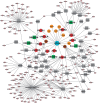Combinatorial therapy discovery using mixed integer linear programming
- PMID: 24463180
- PMCID: PMC4016706
- DOI: 10.1093/bioinformatics/btu046
Combinatorial therapy discovery using mixed integer linear programming
Abstract
Motivation: Combinatorial therapies play increasingly important roles in combating complex diseases. Owing to the huge cost associated with experimental methods in identifying optimal drug combinations, computational approaches can provide a guide to limit the search space and reduce cost. However, few computational approaches have been developed for this purpose, and thus there is a great need of new algorithms for drug combination prediction.
Results: Here we proposed to formulate the optimal combinatorial therapy problem into two complementary mathematical algorithms, Balanced Target Set Cover (BTSC) and Minimum Off-Target Set Cover (MOTSC). Given a disease gene set, BTSC seeks a balanced solution that maximizes the coverage on the disease genes and minimizes the off-target hits at the same time. MOTSC seeks a full coverage on the disease gene set while minimizing the off-target set. Through simulation, both BTSC and MOTSC demonstrated a much faster running time over exhaustive search with the same accuracy. When applied to real disease gene sets, our algorithms not only identified known drug combinations, but also predicted novel drug combinations that are worth further testing. In addition, we developed a web-based tool to allow users to iteratively search for optimal drug combinations given a user-defined gene set.
Availability: Our tool is freely available for noncommercial use at http://www.drug.liuzlab.org/.
Contact: zhandong.liu@bcm.edu
Supplementary information: Supplementary data are available at Bioinformatics online.
Figures




Similar articles
-
Sequential computation of elementary modes and minimal cut sets in genome-scale metabolic networks using alternate integer linear programming.Bioinformatics. 2017 Aug 1;33(15):2345-2353. doi: 10.1093/bioinformatics/btx171. Bioinformatics. 2017. PMID: 28369193
-
Fast-SL: an efficient algorithm to identify synthetic lethal sets in metabolic networks.Bioinformatics. 2015 Oct 15;31(20):3299-305. doi: 10.1093/bioinformatics/btv352. Epub 2015 Jun 17. Bioinformatics. 2015. PMID: 26085504
-
Accurate construction of consensus genetic maps via integer linear programming.IEEE/ACM Trans Comput Biol Bioinform. 2011 Mar-Apr;8(2):381-94. doi: 10.1109/TCBB.2010.35. IEEE/ACM Trans Comput Biol Bioinform. 2011. PMID: 20479505
-
Alignment of molecular networks by integer quadratic programming.Bioinformatics. 2007 Jul 1;23(13):1631-9. doi: 10.1093/bioinformatics/btm156. Epub 2007 Apr 27. Bioinformatics. 2007. PMID: 17468121
-
Drug Combinations: Mathematical Modeling and Networking Methods.Pharmaceutics. 2019 May 2;11(5):208. doi: 10.3390/pharmaceutics11050208. Pharmaceutics. 2019. PMID: 31052580 Free PMC article. Review.
Cited by
-
Network-principled deep generative models for designing drug combinations as graph sets.Bioinformatics. 2020 Jul 1;36(Suppl_1):i445-i454. doi: 10.1093/bioinformatics/btaa317. Bioinformatics. 2020. PMID: 32657357 Free PMC article.
-
Preclinical optimization of a broad-spectrum anti-bladder cancer tri-drug regimen via the Feedback System Control (FSC) platform.Sci Rep. 2015 Jun 19;5:11464. doi: 10.1038/srep11464. Sci Rep. 2015. PMID: 26088171 Free PMC article.
-
MGAE-DC: Predicting the synergistic effects of drug combinations through multi-channel graph autoencoders.PLoS Comput Biol. 2023 Mar 3;19(3):e1010951. doi: 10.1371/journal.pcbi.1010951. eCollection 2023 Mar. PLoS Comput Biol. 2023. PMID: 36867661 Free PMC article.
-
Deep graph embedding for prioritizing synergistic anticancer drug combinations.Comput Struct Biotechnol J. 2020 Feb 15;18:427-438. doi: 10.1016/j.csbj.2020.02.006. eCollection 2020. Comput Struct Biotechnol J. 2020. PMID: 32153729 Free PMC article.
-
Machine learning methods, databases and tools for drug combination prediction.Brief Bioinform. 2022 Jan 17;23(1):bbab355. doi: 10.1093/bib/bbab355. Brief Bioinform. 2022. PMID: 34477201 Free PMC article.
References
-
- Bokhari SU, et al. Beneficial effects of a glyburide/metformin combination preparation in type 2 diabetes mellitus. Am. J. Med. Sci. 2003;325:66–69. - PubMed
-
- Cedarbaum JM, et al. L-deprenyl (selegiline) added to Sinemet CR in the management of Parkinson’s disease patients with motor response fluctuations. Clin. Neuropharmacol. 1991;14:228–234. - PubMed
-
- Cohen R, Katzir L. The generalized maximum coverage problem. Inf. Process. Lett. 2008;108:15–22.
Publication types
MeSH terms
Substances
Grants and funding
LinkOut - more resources
Full Text Sources
Other Literature Sources
Research Materials

